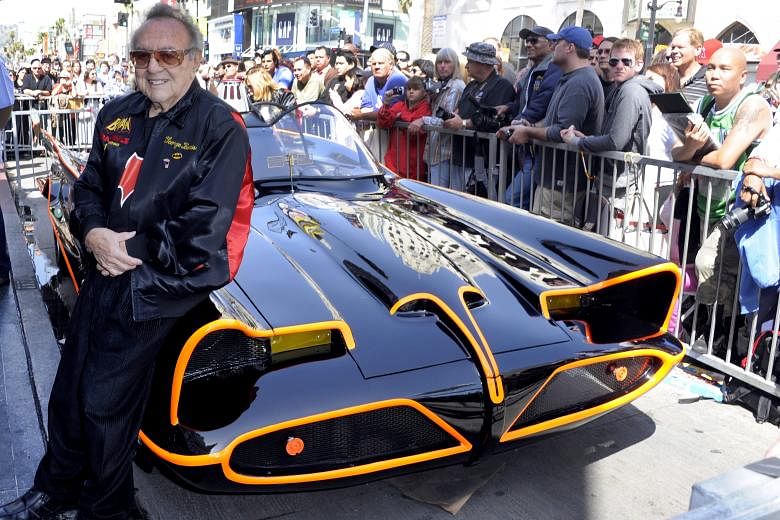NEW YORK • George Barris - a pioneer car customiser immortalised in Tom Wolfe's famous essay The Kandy-Kolored Tangerine-Flake Streamline Baby, and the designer of the Batmobile Munster Koach and other speciality cars for TV and film - died on Thursday at his home in Encino, California.
He was 89.
A spokesman for Barris Kustom Industries confirmed his death.
The veteran of the body shops of Sacramento and Los Angeles was a towering figure in the Southern California subculture of customisers and hot-rodders, known both for the sophistication of his design work and his flair for self-promotion.

He and his older brother Sam treated standard-issue Mercurys, Buicks and Fords as mere starting points for reinterpretation.
They stripped away trim, reshaped body parts and pirated grilles, headlights and taillights from other car models.
He created his own line of outre paints, called Kandy Colors, to impart lustre and depth to vehicles that became, in effect, rolling works of street art.
In his baroque phase, he designed a slew of special-order cars for television, most famously transforming a 1955 Lincoln Futura concept car, in three weeks, into the finned Batmobile for the 1960s series Batman.
He also spliced a 1921 Oldsmobile and a flatbed pickup for the sitcom The Beverly Hillbillies, and incorporated a coffin in creating the family car on The Munsters, calling it a Drag-u-La.
"He made a look - the Southern California customised car look - that was very distinctive," said John DeWitt, author of Cool Cars, High Art: The Rise Of Kustom Kulture.
"But his great contribution was putting customising on the map. He was a phenomenal publicist and showman. L.A. was the perfect place for him."
He was born George Salapatas in Chicago and raised in Roseville, California.
The Barris name was fashioned from Salapatas and another family name, Badacardes.
The Barris brothers' creations reached a national audience through car shows and magazines, and model kits sold by companies like Revell, Aurora and AMT.
One car sealed their reputation: the Hirohata Merc, a 1951 Mercury Club Coupe they turned into a sleek, elongated teardrop.
The car, named after its owner Bob Hirohata, expressed the Barris aesthetic in its classic period.
The brothers extended the front and rear fenders, removed the chrome trim, lowered the roof, dropped the chassis to within a few inches of the ground and painted the car an arresting sea-foam green with dark green panels.
Two 1953 Lincoln taillights were "Frenched", or smoothed into the contours of the fender, and a new grille was fashioned from three 1951 Ford grilles.
It was the hit of the 1952 Motorama show in Los Angeles and a superstar after it appeared on the cover of Motor Trend.
Rod And Custom magazine documented Hirohata's journey as he drove the car on Route 66 to the Indianapolis Custom Show, where it took first prize.
Ala Kart, a customised 1929 Ford pickup, won the America's Most Beautiful Roadster trophy at the Oakland Roadster Show (now the Grand National Roadster Show) in 1958 and 1959.
"It gives you a feeling that you've done something to make a better world," Barris told Rod And Custom in 1962.
Detroit took note.
In the early 1960s, Ford hired him to customise production cars for two exhibitions.
Before long, the innovations of customisers such as Barris began finding their way into the new breed of muscle cars, a development that spelt the end of the golden age of customising.
In 1958, a year after Sam moved back to Sacramento for a quieter life with his young family, Barris married Shirley Ann Nahas, who helped manage his business until she died in 2001.
His survivors include a son, daughter and grandson.
His cars gained cachet with film actors and other notables.
He did his first celebrity job for Lionel Hampton, the jazz musician - a Jaguar - and a slew of commissions followed.
He created a 1954 Cadillac Eldorado for Liberace with sterling-silver grand-piano hood ornaments that played I'll Be Seeing You when opened.
His celebrity projects also included Elvis Presley's 1960 Cadillac Fleetwood (with a gold-plated record player, drinks cabinet and shoe buffer inside), a gold Rolls-Royce for Zsa Zsa Gabor and a caricature golf cart, with ski-jump nose, for Bob Hope.
Inevitably, the movies came calling.
After the Hirohata Merc made an appearance in the 1955 film Running Wild, with Mamie Van Doren, Barris built two duplicate chopped and channelled 1948 Chevy stunt cars for the drag-racing scene in High School Confidential, and the chopped Mercury that James Dean drove in Rebel Without A Cause.
For TV, he also designed the fictional 1928 Porter driven by Jerry Van Dyke in My Mother The Car.
In 2013, the Batmobile, which he had owned through the years, sold for US$4.62 million at an auction in Scottsdale, Arizona.
"Look, I'm just a crazy car guy, and I'm proud of it," Barris told USA Today in 2005.
"My love for this nutty stuff keeps me coming in the office every day, eight o'clock sharp."
NEW YORK TIMES

